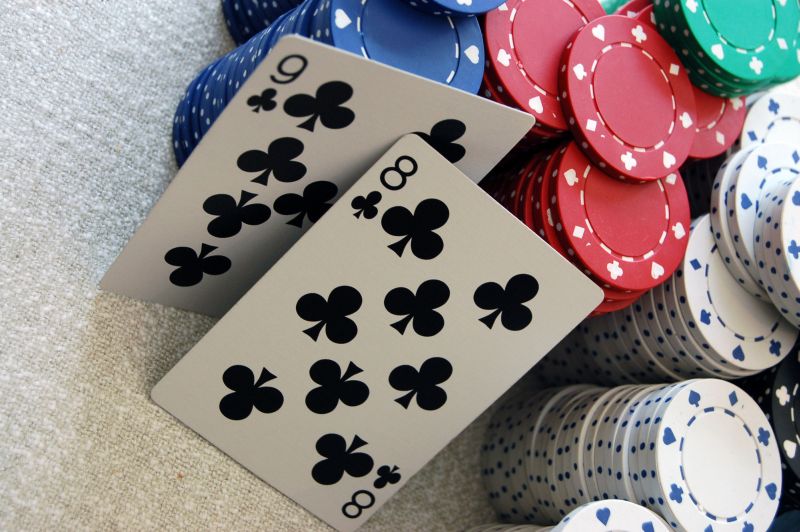Top Tips for Playing Suited Connectors
7 years ago

26 Jul
(Photo: Static.pokerist.com)
Suited connectors are the prettiest-looking hands of all in poker, and although AA and KK are the ‘daddies’ when it comes to the adrenaline rush, the 9♠10♠ give you goosebumps of their own – the sneaky suspicion that they are going to hit straights and flushes and crack your opponent’s big pocket pair!
However, as pretty as suited connectors are, and as happy as you feel when they hit, they are a deadly hand for your bankroll if you’re playing them wrongly – remembering only the good times and conveniently forgetting the hundreds of times when you missed your draw and were forced to fold.
There are quite a few ways, though, in which we can ensure that we play them wisely and make them +EV cards rather than long-term losers. First let’s look at the different schools of thought on how you should play them.
♣ ♠ ♦ ♥
Old-school - to play suited-connectors you need a lot of opponents
This is the traditional approach, which says that because you have a drawing hand, you need a large field against you to justify the odds of your draw coming in.
If you flop an open-ended straight draw, you’re only about 17% to hit your straight by the river – so you need to make enough money when you do hit to justify the times when you’ll be forced to fold.
This makes sense, in that more opponent’s means more money in the pot, and deeper stacks also come into play, as you need people to be able to pay you off when you hit, however…

Modern school - the game is more aggressive and you’re less likely to see a flop
Poker nowadays has advanced a lot. Pots are open-raised much more often,3-betting is commonplace and 4- or 5-betting ranges are well thought out and practiced. The chances of limping in or calling with your pretty little suited-connectors are much fewer, and post-flop play is also more aggressive and accurate than it was before at most levels.
Getting the right price for your draws is not so easy. Simple tricks like re-raising the flop to provoke a check on the turn, thus increasing your odds of hitting, is just as likely to be hit by a re-raise or shove in many games.
The modern school of thought places more emphasis on playing hands aggressively, which means raising with your connectors, and pushing them harder on the flop. Effectively trying to win hands without having to make one!
Now there are arguments against this approach, but modern-day players simply don’t sit around waiting for your flush to come in. The problem for suited connectors in modern poker is, you’re not going to win unless you hit your hand – and that’s not so easy - and now it is more expensive to try.
Cash game play
The first thing to note is that generally in cash games you will be playing deeper-stacked than in tournament play.
This is important because your suited connectors will generally be a drawing hand (most flops won’t hit your hand hard enough to be a made hand, particularly in raised pots) so you need the opposition to have big stacks to pay you off when you do hit.
The other point is that short-stacks in tournaments often won’t allow you to see a flop cheaply: Consider your 8♥9♥. Do you want to play a big pot or stack off against a short-stacks A♣ 9♦? Well you’re a 66/34 dog in that situation, so you should be avoiding it. Naturally, in cash games unless you have a min. buy-in crazy at the table, you won’t have this particular problem.
♣ ♠ ♥ ♦
So, let’s try to lay down some proper pre-flop guidelines for suited connectors in cash games…
Early position to middle position, full ring, full stacks – pretty much just fold them! Very occasional open-raises to mix up your game. No calling.
Early position to middle position, 6-max, full stacks - pretty much just fold them again! Very occasional open-raises to mix up your game. No calling.
Late position, full ring, full stacks – play them if you’re almost guaranteed to be getting in cheaply, then push them as hard as the flop texture allows. Don’t sit around waiting for them to hit - your odds when up against big hands get wider from flop to turn and river.
Late position, 6-max, full stacks - as above, but with a little more leeway.

Tournament play
Suited connectors lose a lot of their value in tournament play, including SnG events, as very often there will be shorter stacks facing bigger blinds and willing to go all the way with their half-decent hands.
Many half-decent hands are still big favourites against suited connectors Ax hands being anywhere from 50-60% against your 8♦9♦, for example.
If the pot is limped around to you in late position, feel free to raise occasionally. You’ll take down some pots and have a better image post-flop in those which go that far, allowing you to play more aggressively. That’s when landing a huge pot happens most often, as your hand is well-disguised.
However, don’t get caught up in some crazy pre-flop war with the blinds – save that for your genuinely good hands.
In all these situations don’t be scared to let go of them if the betting and or flop texture simply don’t fit. Small hands, small pots unless you flop a real monster. Playing 5♣6♣ and flopping a flush is not necessarily a ‘real’ monster, just a baby one!
♣ ♠ ♥ ♦
The earlier you are in a tournament, of course, the more the connectors will play like in a deeper-stacked cash game. Raising from the button or cut-off is fine, even with hands as low as 45s or 56s, if play has folded around to you.
Of course, when the flop hits, be prepared to get out of there if it gets too hot. In tournaments when your stack is gone that’s pretty much it, so don’t go getting all crazy. You miss the flop, you’re mucking to any bet. You hit top pair and you’re also out of there 9 times out of 10.
It’s only when you hit a made hand or a great draw that you’re getting involved, and even then you need to be sure of your odds.
Once the blinds start to rise in the middle of a tournament, the value of your suited connectors drops. You simply can’t be limping and calling and frittering chips away, and you can’t push them too hard as you’ll be risking too big a part of your stack. The best thing to do here is pretty much remove them from your play except as the occasional blind stealing hand. Or, of course, if it’s really cheap to play.
When the blinds get very high, their value is as a fairly decent blindstealer. You can’t sit around and wait for premium hands if you’re on an M of 20 or 25, so you have to pick some spots which are ripe for a wee bit of theft.
The good thing here is that, if you get away with the blinds then all well and good. But if you run into big, big hands then suited connectors actually do reasonably well against them, 78s for example being 5% better off against AA than QQ is, and you’re only a 40/60 dog against big Ax hands. By now you should be looking for those opponents who have tightened their play up and pick on them.
Eventually in tournaments you’ll get down to the nitty-gritty, and here you have a simple fold-shove play left. Shove against anyone you consider to be playing too tight, fold against those who seem to know what they’re doing.

Overall, playing suited connectors is fairly simple
Position is a massive factor in poker most of the time, but with suited connectors this increases. Your hand simply isn’t strong enough to get involved in a raising war, and you lose most of your ability to manipulate the play post-flop if you don’t have position.
Playing them in early-to-middle position is only ever a way to mix things up and you won’t get away with this at fast and loose tables.
The dynamics of the table are very important too. Suited connectors work well against passive players, and those who haven’t shown that they understand what’s going on at the table. You’ll get to see more flops against these types, and also get paid more when you do hit.
Knowing when you’re playing a draw hand or a blind-stealing hand is important in this respect.
The strength of your suited connectors has to be taken into account. Small connectors have very little value in most spots; bigger flushes and straights hit them hard. However, as we saw in the example above, there are tricky spots whatever our connector are, or what flop they hit.
Be aware also that the strength of your connectors doesn’t rise hugely when you drop from full-ring to 4- or 6-max tables. Play them almost the same way.
The texture of the flop should dictate your play so be perfectly willing to muck your hand if things are looking iffy. You can’t get too committed to these hands as they will burn a hole in your pockets if you don’t learn to let them go.







Comments
You need to be logged in to post a new comment